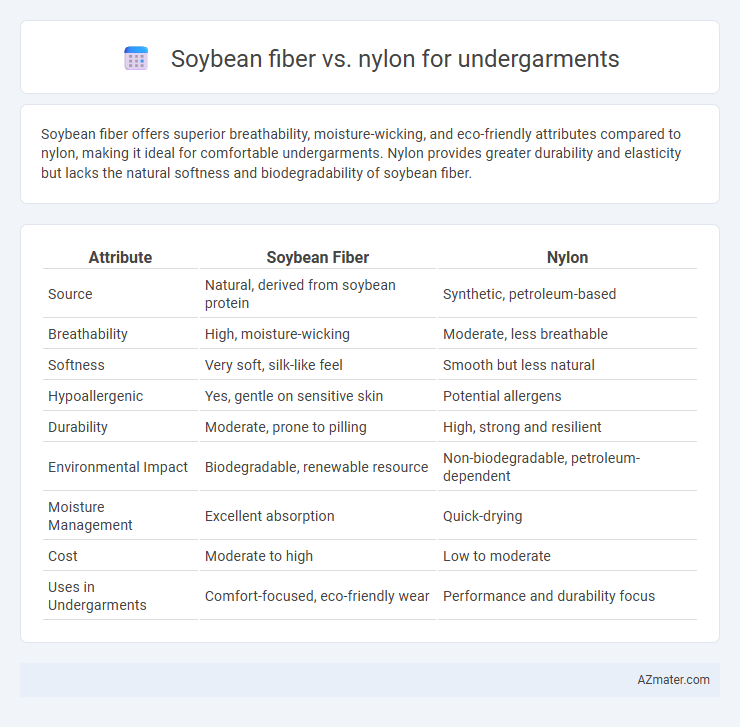Soybean fiber offers superior breathability, moisture-wicking, and eco-friendly attributes compared to nylon, making it ideal for comfortable undergarments. Nylon provides greater durability and elasticity but lacks the natural softness and biodegradability of soybean fiber.
Table of Comparison
| Attribute | Soybean Fiber | Nylon |
|---|---|---|
| Source | Natural, derived from soybean protein | Synthetic, petroleum-based |
| Breathability | High, moisture-wicking | Moderate, less breathable |
| Softness | Very soft, silk-like feel | Smooth but less natural |
| Hypoallergenic | Yes, gentle on sensitive skin | Potential allergens |
| Durability | Moderate, prone to pilling | High, strong and resilient |
| Environmental Impact | Biodegradable, renewable resource | Non-biodegradable, petroleum-dependent |
| Moisture Management | Excellent absorption | Quick-drying |
| Cost | Moderate to high | Low to moderate |
| Uses in Undergarments | Comfort-focused, eco-friendly wear | Performance and durability focus |
Introduction to Soybean Fiber and Nylon in Undergarments
Soybean fiber is a natural, eco-friendly material derived from soybean protein, known for its softness, breathability, and moisture-wicking properties, making it ideal for undergarments that prioritize comfort and skin health. Nylon, a synthetic polymer widely used in undergarments, offers high durability, elasticity, and excellent shape retention, providing strong support and long-lasting wear. Comparing the two, soybean fiber emphasizes sustainability and natural feel, while nylon focuses on strength and performance in undergarment fabrics.
Origin and Production Processes
Soybean fiber is derived from soybean protein extracted during the oil production process, then regenerated into a soft, breathable fiber using environmentally friendly wet spinning techniques. Nylon, a synthetic polymer, originates from petrochemical sources and is produced through a high-temperature polymerization of caprolactam or hexamethylene diamine with adipic acid, resulting in a strong, durable fiber. The sustainable origin of soybean fiber contrasts with the energy-intensive, non-renewable production of nylon, influencing their environmental impact in undergarment manufacturing.
Comfort and Wearability Comparison
Soybean fiber offers superior breathability and moisture-wicking properties compared to nylon, enhancing overall comfort for undergarments. Its natural cellulose structure allows better temperature regulation, reducing skin irritation and promoting softness. In contrast, nylon provides high durability and elasticity but tends to trap heat and moisture, which may compromise wearability during prolonged use.
Moisture-Wicking and Breathability
Soybean fiber offers superior moisture-wicking properties compared to nylon due to its natural hydrophilic structure, which efficiently absorbs and releases sweat, keeping the skin dry and comfortable. In terms of breathability, soybean fiber allows better air circulation because of its porous texture, enhancing ventilation and reducing heat buildup during wear. Nylon, while durable and quick-drying, tends to trap heat and moisture, making soybean fiber a more breathable and moisture-managing option for undergarments.
Durability and Longevity
Soybean fiber offers moderate durability with good resistance to wear, making it suitable for comfortable undergarments but less robust than synthetic options. Nylon excels in longevity due to its high tensile strength and excellent abrasion resistance, ensuring undergarments maintain shape and integrity over extended use. The superior durability of nylon makes it ideal for undergarments requiring long-term performance and frequent washing.
Skin Sensitivity and Allergenicity
Soybean fiber offers superior skin sensitivity due to its natural, hypoallergenic properties and moisture-wicking capabilities, making it ideal for individuals with sensitive skin. Nylon, a synthetic fiber, may cause irritation or allergic reactions in some users because of its non-breathable nature and potential chemical residues from manufacturing. Choosing soybean fiber for undergarments reduces the risk of allergic responses and enhances comfort for those prone to skin sensitivities.
Environmental Impact and Sustainability
Soybean fiber, derived from natural plant sources, offers a biodegradable and renewable alternative to petroleum-based nylon in undergarments, reducing environmental pollution and reliance on fossil fuels. Nylon production generates substantial greenhouse gas emissions and microplastic pollution, while soybean fiber decomposes more rapidly and supports sustainable agriculture practices. Choosing soybean fiber enhances the sustainability profile of undergarments by minimizing carbon footprint and promoting eco-friendly textile manufacturing.
Maintenance and Care Instructions
Soybean fiber undergarments require gentle washing in cold water and air drying to maintain their softness and prevent shrinking, as they are prone to damage from high heat and harsh detergents. Nylon undergarments are more durable, allowing for machine washing in warm water and tumble drying on low heat, but frequent exposure to heat can degrade fiber strength and elasticity. Proper care extends the lifespan of both fabrics, with soybean fiber needing more delicate handling while nylon benefits from avoiding fabric softeners and bleach to preserve its structure.
Cost and Market Availability
Soybean fiber offers a cost-effective alternative to nylon in undergarments, often priced lower due to its renewable source and less intensive manufacturing process. Nylon remains more widely available in the market, benefiting from established production infrastructure and broad industry adoption. Consumers seeking affordable, eco-friendly options may prefer soybean fiber, while those prioritizing durability and widespread retail presence often choose nylon.
Conclusion: Choosing the Best Fiber for Undergarments
Soybean fiber offers superior breathability, natural moisture-wicking, and eco-friendly benefits, making it ideal for comfortable, sustainable undergarments. Nylon provides excellent durability, elasticity, and quick-drying properties, suitable for high-performance or athletic wear. Choosing the best fiber depends on prioritizing comfort and sustainability with soybean or durability and stretch with nylon for undergarments.

Infographic: Soybean fiber vs Nylon for Undergarment
 azmater.com
azmater.com